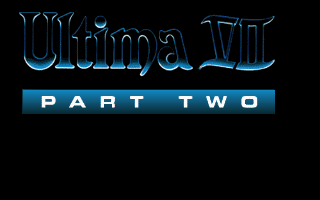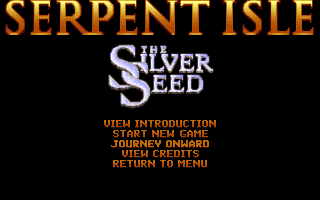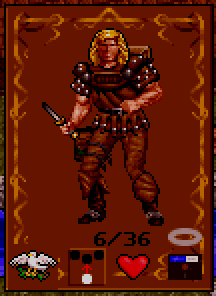Part 1: SERPENT ISLE - Where Ultima Went to Die
Ultima VII Part 2: Scenic Serpent Isle, Where Ultima Went to Die!


What Is This?
First of all, I strongly recommend you read my Let's Play of Ultima VII Part 1: The Black Gate. Not just because I like pimping my own threads, but because the game makes a lot of assumptions about the Ultima series and a player's familiarity with it. You can play (and enjoy) Serpent Isle without knowing diddly about the characters or legends (since the game doesn't take place in the same world as the previous four or so games), but it helps. A lot. And the way I'm treating the story of the Avatar is... different.
But let's move on, shall we?
Ultima VII Part 2: Serpent Isle (or Ultima VII: Part 2 - Serpent Isle, or whatever the hell it is, we will be calling it Serpent Isle) is a computer role-playing game by Origin Systems, Richard Garriott's legendary game studio that launched a bunch of careers, got bought by Electronic Arts, and died a slow horrible death floundering in the cold, lifeless sea of Ultima Online's dwindling revenues. Incidentally, the game is from late 1992 and early 1993, right after EA made their purchase.
There is a definite EA feel to the game that the previous game, the shockingly-titled Ultima VII [Part 1]: The Black Gate avoided. The game is more linear, more rushed, and full of fewer goodies and secrets. Despite that, EA's meddling was (relatively) minor in the grand scheme of things, and Serpent Isle not only proved itself a very good RPG, but that EA doesn't kill every franchise it touches... immediately.
It took two more games to do that.
Why Ultima VII: Part 2? Why Not Ultima VIII?
Ultima VII's story wasn't really complete at the end of The Black Gate. The mysterious new villain, the Guardian, had been foiled temporarily, but his lackey Batlin escaped at the last minute. Since neither the Guardian's motives not Batlin's fate were known, the plot had the potential to continue.
Of course, many games continue their storylines in sequels, so the numbering still seems a little odd. The real answer is that Serpent Isle just isn't a completely new game. The engine used is exactly the same as that of The Black Gate, with some improvements and tweaks, but the graphics and scripting are pretty much the same. Origin probably didn't think a new game number was justified when the game was so closely tied both mechanically and in story terms with their previous offering.
Also they were saving Ultima VIII for when their games got shitty.
So What Is Different?
A few things. First of all, the graphics have been touched up in a variety of areas. Armor and weapons are a little more detailed, exterior environments are more varied, there's new art assets for ancient ruins and icy wastelands, and so forth. But probably the best improvements come in the form of the "paper doll" inventory system and the character portraits.
Let's try an example here, shall we? On the left, we have the Black Gate's inventory screen. On the right, Serpent Isle's (if you read the Black Gate thread you've already seen this, as the Exult emulator allows you to use SI's interface improvements).


Impressive difference, isn't it? The armor and weapons actually appear on the character's model (well, it's a sprite, but it's a sprite of a model, if I'm making sense here). It's just generally more detailed and gives you a better sense of what the characer is actually wearing. This is going to be very important as it will allow the Avatar to be made to look ridiculous. And it won't even be my fault.
Then of course there's the portraits. Here's Iolo's portrait in Black Gate:

Tiny (it's blown up to 2x size here), unattractive, overly-busy borders, you name it. And in Serpent Isle?

Much nicer. More detailed, less intrusive borders, generally more recognizable. The main difference is that the portraits in Black Gate were drawn, while here they're basically photoshopped from photographs. If they had photoshop at the time. Given the quality of some of the edits (which range from "impressive-looking" to "they took a photo and drew horns on it and then fill-bucketed it red in Paint to make a gargoyle"), they can't have been paying much for the program, whatever it was.
The game also includes hotkeys for commonly-used activities like using keys. The expansion even adds a nifty keyring item so you don't have to actually keep track of what the glowing green key goes to. There are other neat things in the game to streamline some of the micromanagement, but a few of them are spoilers, so I'll go over them when they're found.
Serpent Isle is more linear than Black Gate; you can't go everywhere in the world at whim, and the plot is more linear. This is good and bad. It's bad because you can't go out in a boat and explore the world, but it's good in that the story is kept more tightly focused and the game designers can futz with the game engine to create new areas, places to teleport to, multiple floors in dungeons, and so forth, none of which were quite workable in the wide-open world of Part 1, where spoiler areas had to be crammed inside unrelated mountains so the player wouldn't find them. It's good in that the linear storyline allowed them to tighten up the plotting, pacing, and characterization.
This shows a lot in the writing quality. Although the game as a whole was rushed (more on that in the endgame, whenever we get there, because it doesn't really show until then), you wouldn't necessarily know it from the NPCs. There are far, far fewer than in Part 1, but they tend to have leagues more personality and deeper, more meaningful conversation trees. Although you won't find Laurel and Hardy sendoffs randomly laboring in a mine, the NPCs in the cities are actually intriguing personalities so you won't really have to. They tend to do a lot more than just convey the plot.
Let's see, what else? Oh yeah: Hardcore nudity. No seriously. Well, okay, as hardcore as pixelated nipples, penises, and bush can be. But it's there. Several times. In the main storyline. And the optional areas.
What Exactly Is The Serpent Isle?
Since a lot of folks aren't going to have access to the manual (I had no less than three copies in my day, one from the game itself, one from the Ultima VII Collection, and one rather crappy one from The Complete Ultima), I'll briefly go over it. The manual for Serpent Isle is written in first-person by a wizard named Erstam. Erstam is a very old wizard, who has been alive since the time of Ultima III, when the Avatar (though he/she wasn't yet the Avatar) fought and defeated Exodus, a demonic supercomputer. Erstam had seen a lot of nasty shit go down in the lands of Sosaria, including the fragmentation of the world's many lands when the wizard Mondain (Exodus's "father") was killed. So he was understandably pissed when some nutcase named Lord British decided to rename what was left of Sosaria "Britannia" and proclaim himself king.
Erstam knew the other lands of Sosaria hadn't actually been destroyed, just dimensionally separated, so once he found the mysterious Serpent Pillars (which led to what was in Ultima I called the Lands of Danger and Despair), he decided he'd solve the problem by getting out of town. The citizens of the towns of Fawn, half the citizens of Moon, and the citizens of the twin cities of Montor and Monitor decided they'd go with him, since none of them particularly liked Lord British either. This explained the disappearance of the towns after Ultima III (or, in the case of Moon, why it became Moonglow; the one in Serpent Isle is named Moonshade).
Once they arrived in what was once the Lands of Danger and Despair, the new settlers realized something crazy had happened there. There were ruins everywhere that employed serpents as their motif, leading the inhabitants to name the place the Serpent Isle. There had apparently been an ancient civilization that covered the entire isle, but in the many thousands of years since Sosaria was divided they had all died out.
Most of the immigrants didn't care. They called the old inhabitants daemons and didn't much wonder if they were dead or alive. Besides, all accounts were they were long gone. Plus, the isles had other dangers, like the mysterious swamps and haunted castles in the north, the icy wastelands that covered a third of the island, and of course, a horde of well-organized goblins.
Erstam documented a bunch of stuff (the manual info on flora and fauna, spells, etc.), but eventually retired from public life, feeling that the people of Serpent Isle had become as ignorant and stupid as the Britannians were when Lord British set himself up.
From this, we can gather two very important things: First, nobody knows who the Avatar is. The Quest of the Avatar had just been introduced when Erstam and his allies decided to skip town, so even Erstam doesn't know anyone ever actually became the Avatar. Second: Nobody knows that the "Stranger" who defeated Exodus is now the Avatar. In the manual, Erstam even muses that the Stranger may have returned to depose the tyrant British.
In Steve's case, he was surprisingly prescient. Anyway, everyone hates the "Beast British," which is a remarkably funny in-joke at Richard Garriott's expense. Also the island has serpents. So it is the Serpent Isle. You see how this works?
Silver Seed?
Expansion pack. Pretty much bundled into every copy of Ultima VII you could find anymore, it's considerably less monty haul than The Forge of Virtue for The Black Gate. But it does have some ridiculous parts. The plot of the Silver Seed is only tangentially related to the main plot of Serpent Isle, but it does reveal something about the backstory, which means I'll have to be careful about when I do the expansion (you could theoretically do it from nearly the start of the game, but you wouldn't necessarily want to, and there's an "ideal" point at which to do it, as I will demonstrate).
Exult?
An open-source emulator for the Ultima VII games. Ultima VII's engine was a little weird, almost a mini-OS unto itself, often requiring the aspiring player to go into DOS and then reboot his parents' 386 into a particular XMS/EMS configuration before the game would even run. And even then, it'd usually lock up. Understandably this means the game is rather hard to get working in XP or Vista. Exult solves the problem by basically rewriting the old system into a newer, more Windows-friendly (or Mac-friendly, or Linux-friendly, this is open-source) program. If you have a copy of the game and want to play it, don't bother going through all the trouble of trying to make it work. Download Exult, point it at the game directories (which you can just copy directly from the CD, since the DOS-based installers never work), and it should be fine. DosBox also works if you tell it the right memory settings, if you'd prefer the "authentic" experience.
Crashing aside, though, Exult is just vastly superior. It's got better memory handling, a nicer camera system, support for anti-aliasing and different resolutions, variable difficulty, an infinite number of saves, and so forth. About my only complaint about Exult has always been the inferior Hack Mover cheat, which doesn't let me shovel everything in the entire game into a single backpack. I found a workaround in The Black Gate, so I'm less concerned about that now.
Is There A Game Script Or Dialogue Dump?
Yes. Or rather, not until just now. Thanks to the herculean efforts of fellow goon cmndstab, I've been able to assemble (well, mostly assemble, it's not done yet) a dialogue dump. All the text in the game is stored in a series of files in the Serpent Isle directory, and using a program developed for The Black Gate I was able to extract them all to one gigantic text file. Formatting it has been a nightmare, so it's great to have help from someone else who really knows this game. The end result of all this is that the text dump will be available, in a readable and semi-consistent format, as soon as the two of us are finished with it. Naturally, there will be spoilers within, but if you've already played the game a million times before you might be interested in seeing all the little details.
And Your Update Schedule?
Manic, as usual, though perhaps not as manic as usual. The text dump isn't fully ready, for starters, but I don't need it to do the first few updates. I expect it'll take me some time to get back into the swing of things as well. The game is more text-heavy than the first one, and I'm always pretty busy, so updates may cover less than usual in order to cover the same amount of text. We'll settle into a groove soon enough, I'm sure.